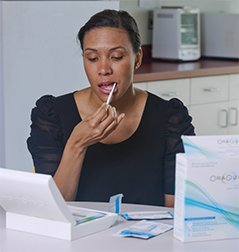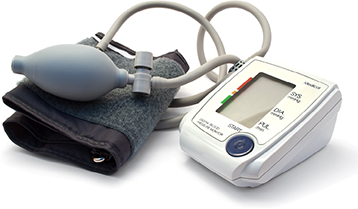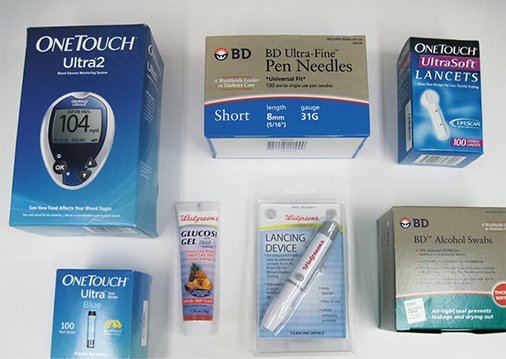9.3 Medical and Home Health Supplies and Equipment
Community pharmacies also sell the everyday first-aid and health supplies needed by customers. General health supplies and equipment include the usual bandages, tape, wound dressings, thermometers, heating pads, splints, braces, vaporizers, bathroom accessories, and adult/child diapers. These are all elements that do not need a prescription, and technicians can help patients find these stocked items.
 Work Wise
Work Wise
When customers are looking to find a certain test kit, it is important to be particularly courteous, as some conditions can make them feel uncomfortable, ashamed, vulnerable, or scared for the future.
Parents will often come into the pharmacy worried about a child with a high fever, looking for the right thermometer. Technicians need to become acquainted with the range available. Different types have different features, and it is helpful for a technician to be able to explain the differences to concerned parents. There are electronic/digital, infrared, and mercury thermometers for use in the mouth, armpit, rectum, ear, forehead, and vein areas. (Mercury thermometers are being phased out.) Oral thermometers are for those who can hold them under the tongue, which is often difficult for children or seniors. Rectal thermometers are generally used for infants. If customers have specific questions about the best type for detecting a specific illness or for a patient who is difficult to care for, the pharmacist should help them.
Pharmacies also have specialized supplies suited for aging patients and specific chronic conditions, such as heart disease, respiratory diseases, and diabetes. Disposable medical supplies include such items as test kits, needles, and sterilizing wipes. Durable medical equipment (DME) and supplies are reusable and long-lasting for ongoing needs. DME includes canes, wheelchairs, walkers, crutches, blood pressure monitors, blood sugar monitors, nebulizers, and oxygen equipment, among other typical items. These are often prescribed by physicians.
It is helpful to be familiar with some of the key medical supplies and equipment sold in a community pharmacy.
Test Kits
People often want to diagnose and treat themselves, so they buy test kits to help them discern their conditions. Some of the most common test kits requested by patients include the following:

OraQuick is a screening test for those who fear that they may have contracted HIV.
 Practice Tip
Practice Tip
An adult’s normal temperature range is generally one degree above or below 98.6°F (37°C) taken orally and 99.6°F (37.5°C) rectally. However, a baby’s normal temperature can range from 97.5°–99.3°F (36.5°–37.4°C) taken under the arm and up to 100.3°F (37.9°C) rectally, which is more accurate. An ear thermometer should not be used from newborn to six months.
pregnancy
ovulation cycle
bladder infection
high cholesterol
illegal drug use
human immunodeficiency virus (HIV) infection
Occasionally, the pharmacy may need to special order a less-requested test kit for a customer. The pharmacy technician can help customers select a test kit and understand the test instructions and outcomes. Patients will want to confirm the test finding with a doctor. Letting patients know where community clinics are in the area can be helpful.
 IN THE REAL WORLD
IN THE REAL WORLD
An estimated 200,000 individuals are unaware that they are infected with HIV, but a test kit, OraQuick, can help reduce this number. This kit is designed for home screening for those age 17 or older. The FDA-approved OraQuick can detect the presence or absence of the virus in one’s saliva. After the mouth is swabbed, results come within 20 minutes.
Consumers, however, need to understand that the results are not 100% accurate, and technicians should mention this. A positive test result is rarely wrong, but a negative test result may be. This means that if the test recognizes the presence of the HIV antibodies, it is most often correct, but it can miss 8 out of 96 patients who are HIV infected. Sufficient antibodies may not yet have developed. Patients who test positive on the OTC test should see their primary care providers soon for confirmatory testing. Those who test negative may still want to see their physician and should test again at a later date. The manufacturer also provides a toll-free phone number for individuals to call to discuss their results with a trained staff member or to get a referral to a local health center.
Blood Pressure Monitors
Patients with high blood pressure often seek home monitors. They may want (or be urged by a prescriber) to purchase a type of sphygmomanometer for home use. A sphygmomanometer is a blood pressure gauge and cuff similar to that used in a physician’s office. Many patients prefer to purchase a digital blood pressure cuff for their wrist as it is easier to use by oneself. Its results can be recorded and brought to the physician’s office on the next visit.

A digital blood pressure unit with a wrist cuff is easier to use for home use than an arm cuff.

This is an example of a peak flow meter, which measures one’s lung/breath capacity to monitor respiratory diseases such as asthma.
Respiratory Management Supplies—Inhalers and Nebulizers
Many children and adults suffer from asthma and other diseases that cause breathing issues, and they take prescribed medications through a metered-dose inhaler (MDI). It is a small, pressurized canister of a prescribed medication that is pumped out in specific doses for inhaling. Some patients need a plastic spacer device, or extension tube, to deliver the medication more effectively. Spacers are particularly beneficial for the very young as well as elderly patients who may have difficulty with coordinating the movement needed for deep inhalation into the lungs. Spacers come in small, medium, and large sizes. If written as a prescription, the spacer will be covered on some drug insurance plans. Prescribers may also recommend that some respirator patients purchase an adjustable plastic peak flow meter to measure their breathing expirations to assess the severity of their asthma symptoms or the therapy benefits.
Occasionally, prescribers order medications in nebulizer form for patients with the acute wheezing or shortness of breath that accompanies chronic obstructive pulmonary disease (COPD). A nebulizer is a battery- or electric-powered machine that turns the asthma medicine into a fine mist that can be inhaled deep into the lungs to ease breathing difficulties. The pharmacy technician completes the processing for billing an insurance plan for the home nebulizers and medications. These both require prescriptions with diagnosis codes (ICD-10) for insurance coverage.
Diabetic Management Supplies
Nearly 10% of US citizens are affected by diabetes, and the percentage is growing. Community pharmacies offer a wide range of products to serve these patients. Even special therapeutic footwear for patients with diabetes, which helps prevent injury, may be prescribed or recommended by physicians and carried by some community pharmacies. Many pharmacists acquire specialty training and certifications in serving patients with diabetes and matching them with the particular drugs and supplies they need.
 Practice Tip
Practice Tip
To assist a patient needing insurance to pay for diabetic shoes, you will need to complete a foot assessment form and receive a diagnosis and ICD-10 code from the physician.
Pharmacy technicians can complete a special diabetes training, pass an examination, and become certified in patient education for patients with diabetes. Such skills are considered valuable within the pharmacy and may enhance hourly pay. Even without this specialty training, technicians in a community pharmacy are often called upon to assist patients in locating or selecting diabetes supplies, such as a glucometer, insulin syringes, pen needles, test strips, lancets, and alcohol wipes for skin cleansing.
Technicians are also key to helping patients work with the insurance companies to pay for their diabetes supplies and durable medical equipment. Insurance covers many of these items. Below is a sample of some of the varied diabetic supplies pharmacies carry.
Glucometers
To determine the level of glucose in one’s body, and therefore how much insulin is needed, patients can use a glucometer, or blood sugar measuring device. Patients insert a test strip (explanation to follow) in the machine and add a drop of blood (most often from a fingertip). The glucometer then screens the blood to check the glucose levels.

Diabetes patients are often frequent customers, needing glucose tablets and gels, lancets, alcohol wipes, and different sizes and gauges of needles, among other supplies.
Glucometers are available from several manufacturers in different sizes. They vary as to the amount of blood needed to make a reading, the time period necessary to provide the results, the memory capacity, and the ability to interface with a computer. Patients without insurance coverage for this equipment can often purchase glucometers with generous manufacturer rebates that negate the majority of the stated purchase prices. Companies frequently upgrade their glucometers, so it is essential for both the pharmacist and the technician to keep abreast of product changes.
Test Strips, Lancets, and Alcohol Wipes
Specialized disposable test strips are needed with each glucometer. The test strips are machine specific and must be matched for the glucometer type being used. Technicians can assist patients in product matching. Some bottles of test strips come with a computer chip that has a specified lot number that must be inserted in the glucometer. Failure to replace this glucometer chip when using a new bottle of test strips (with a different lot number) leads to errors in the blood glucose readings. Technicians always need to check the expiration dates of the strips as well. Since patients test their blood using new test strips from one to six times daily, strips are expensive if patients do not have insurance coverage. However, purchasing generic or store-brand test strips, especially with discount coupons, can result in up to a 50% patient savings.
 Practice Tip
Practice Tip
Technicians can make patients aware that they can keep an online log of their glucose readings at https://PharmPractice7e.ParadigmEducation.com/Diabetes, sponsored by the American Diabetes Association.
In addition to the test strips, patients need alcohol wipes and lancets, or mini blades, to make the sterile pinpricks to access blood. Technicians can assist them in finding and purchasing these items.
Insulin Syringes and Needles
As explained in Chapter 5, insulin syringes and needles come in different sizes, and technicians can help patients select the correct length and gauge. Remind patients that the higher the gauge of the needle, the smaller the width, potentially resulting in less pain at the injection site. Insulin-pen needles have to be purchased separately and are available with gauges from 29 to 32. Pen-needle lengths are commercially available as original (12.7 mm, or ½ inch), short (8 mm, or ⅓ inch), mini (6 mm, or ¼ inch; 5 mm, or ⅕ inch), and nano (4 mm, or ⅙ inch). The shortest pen needle, which usually causes the least pain, is the 4 mm, 32-gauge needle. States vary in their laws about selling syringes, concerned that they will be used for illegal drug administration. Some pharmacies have a policy that no insulin syringes can be sold unless the patient comes with a prescription or is a known customer of the pharmacy.
 Practice Tip
Practice Tip
Patients with diabetes also may struggle with high blood pessure and may benefit from blood pressure monitoring equipment.
Large Durable Medical Equipment
In addition to the smaller DME, some independent community pharmacies with more storage or warehouse space also specialize in the sale or rental of larger DME, such as hospital beds, wheelchairs, prosthetics, orthotics, and so on. These pharmacies generally host a more limited inventory of standard retail merchandise (products that are nonhealth-related) to have more room for home healthcare supplies and equipment.

The orthopedic equipment to correct a clubfoot in a child or a foot boot for those who have undergone surgery are examples of DMEs that a pharmacy might sell.
Community pharmacies that provide home healthcare supplies and equipment must meet quality standards and accreditation requirements set by the Centers for Medicare and Medicaid Services (CMS). CMS generally awards contracts to pharmacies or medical supply warehouses to provide DME that is directly reimbursable by Medicare Part B. Besides assisting customers in finding and completing the sales for medical supplies, technicians often help assemble the equipment, bill insurance, and restock items.